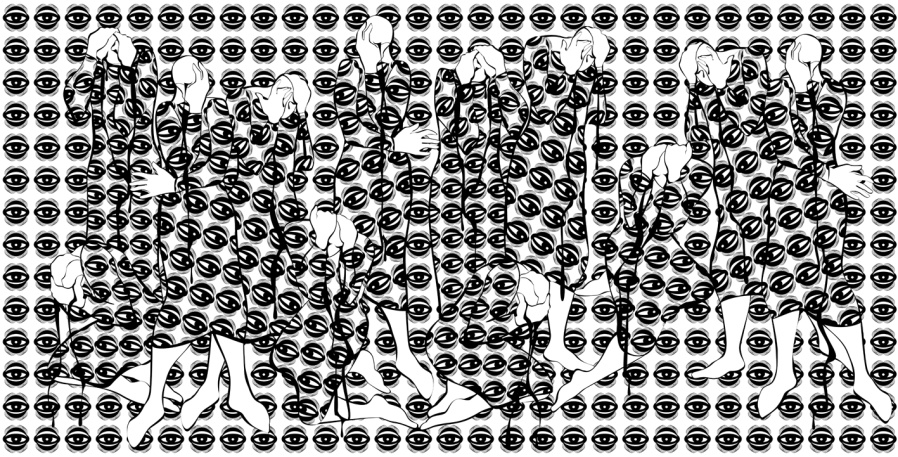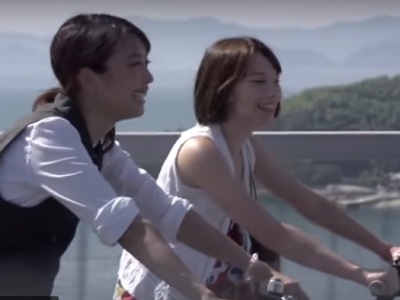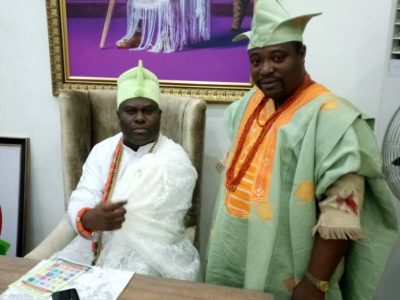
パラストゥ・フォロゥハル 「ウォーターマーク(原題:Water Mark)」溺れゆく難民へのオマージュ、2015 「この作品は、ラトガース大学 ブロツキーセンター のアーティスト・レジデンス・プログラム期間に、ブロツキーセンターの製紙と版画のマスターであるアン・マッケオンとランディ・へミンガウスと共同制作された作品である」アーティスト画像提供
ドイツ在住イラン系ドイツ人アーティストパラストゥ・フォロゥハルは「暴力と不安感、閉塞感をあらわす様々な重なりによる調和と美のシンクロニシティ 」を具現化する巧みな芸術作品を生み出すことで知られている。
自伝的な彼女の作品は、インスタレーション、アニメーション、デジタルドローイング、写真を含む多様なメディアに及ぶ。
1991年、フォロゥハルはイランを後にして芸術の学位を取得したドイツに移り住んだ。彼女の作品はイラン、ドイツ、オーストラリア、ニューヨークのギャラリーや博物館で広く展示されており、ベルリンのドイツ連邦国会議事堂およびロンドンの大英博物館の常設展で見ることもできる。
フォロウハルは、ドイツ のマインツ美術アカデミー、ファインアーツの教授である。彼女の作品は、ニューヨーク市のハイラインナインギャラリーにおいて、著名な写真家シリン・ネシャットが企画した、あなたとすべての架け橋と題された、イラン人女性アーティストのグループ展に現在出品されている。(会期は2019.11/7~12/14)
以下はフォロゥハルとのインタビューの抜粋である。

パラストゥ・フォロゥハル、「目(The Eyes)」 2018 アーティスト画像提供
オミッド・メマリアン(以下OM):あなたの「目」のコレクションは、警察国家と政治的抑圧を想起させます。と同時に、曲線、反復するシンボルとモノクロ使いが、作品が示唆する意味とぶつかり合うかのような調和と平穏を表現しています。鑑賞者である私は、ぎくりとします。 イランがあなたの最大の関心事ですが、この語り口はすべてに通じるように思われます。 このコレクションの動機はなんでしょうか。
Parastou Forouhar:You pointed out something which I consider to be fundamental in a lot of my work: The concurrence of contradictory perceptions the synchronicity of harmony and beauty, which are evident in the patterns and in their accumulation at first glance, along with other layers that display violence and a sense of insecurity and entrapment. Most of the latter layers become evident at second glance. In reality, by engaging the viewer in a work of art, I'm trying to show how to look at things and view them. I want to compel the viewer to look more careffully. As you in some way pointed out,this polarity and contradiction in perception, or the concurrence of opposing phenomena, is part of the human/social condition. You see its manifestation in Iran, but it's not limited to a single society. Or, as you mentioned, it's a universal narrative.
While working on the “Eyes” collection, which is one of my recent works, I was feeling a kind of intense crisis. There are social crisis that stare at us and we seem to be fixated on them with anxiety, unable to overcome them. More than anything, this collection may have risen from the psychological and emotional crises that I'm going through, wheter from the perpetual violence and oppression in Iran, the social collapse resulting from the various wars in the Middle East, growing confrontations with “the other” and fascism in Europe, where I live and work, or the coldhearted brutality against asylum seekers here and there.
パラストゥ・フォロゥハル(以下PF):あなたが指摘したことは、たくさんの自分の作品の中における土台と考えるものです。相反する知覚が同時にあること、つまり一見してパターンや積み重ねの中に明らかな調和と美のシンクロニシティであり、これは暴力、不安感、閉塞感をあらわす様々な重なりです。 その多くがもう一度見ると明らかになってくるのです。 実は私は、見る人を作品に惹きつけることにより、物事の見方と考察の仕方を示そうとしているのです。 より注意深く見てほしいのです。 あなたがある意味で指摘したように、この両極性と知覚の不一致、あるいは正反対の現象が同時に起こることは、人間と社会の状態の一部なのです。 イランにおいて顕著に現れていることですが、一つの社会に限られたことではありません。あるいは、あなたもおっしゃったように、世界に通じることなのです。
最近の作品の1つである「目」のコレクションを制作しながら、一種の深刻な危機感がありました。そこにはわれわれを監視する社会の危機があり、われわれは打ち勝つことのできない不安を伴って、監視社会の危機につきまとわれているようです。 何よりも、このコレクションは、 私が経験している心理的感情的な危機から生まれています。イランにおける永続的暴力と圧制、中東での戦闘による社会崩壊、私が住み活動している欧州における「他者」との対立の増加とファシズム、あるいはそこかしこでの亡命希望者に対する無情な残虐行為、それらすべてにより生み出されたものです。

パラストゥ・フォロゥハル、「赤は私の名前 緑は私の名前 Ⅲ(RED IS MY NAME GREEN IS MY NAME III)」 2015。フォトラグにデジタルドローイング 80 x 80 cm。アーティスト画像提供
OM: あなたの作品の主要なテーマである政治、暴力、差別、不平等、痛みは、「目」、「ウォーターマーク」、そして「赤は私の名前」を含む作品の中ではっきりと認識できる時もあり、様々なシンボルとエレメントに関係性を見出すことが困難な時もあります。 反復するシンボルにそのような調和を生み出させるものは何でしょうか。
PF: Every artist works with life experiences. A person’s emotions and channels of understanding are formed by experiences. I grew up in a family and among a group of people whose main concern in life was to fight for freedom and justice under the dictatorship of the second king in the Pahlavi Dynasty. My father and mother and many of the people around me spent part of their life as political prisoners. In my youth, I witnessed the Iranian revolution and the Iran-Iraq war, along with the brutal suppression of political opponents by the Iranian government, followed by migration and expulsion from my homeland… These situations in life shaped my human emotions and gave rise to my art. My artistic language and forms are based on ornaments and patterns which I gradually picked up over the years and tried to use to express my art. The ornamental structure allows me to present a mixture of visible and hidden meanings, to create beauty, balance and harmony with details that make you feel trapped in an organized turmoil and chaos. I try to create the potential for suspension between contradictory states that will emotionally and psychologically engage viewers and make them ask questions. From a technical standpoint, many of these sets of works are digitally created and printed with wide use of computer programs.
PF:アーティストというものは、人生経験から作品を生み出すといえます。人の感情や理解は経験によって形作られるからです。私は パフラヴィー王朝2世独裁政権の時代に生まれ育ちました。両親はじめ周囲の多くの人たちが、自由と公正を求める生き方を最も重要なこととして戦い、政治犯としてその人生を消耗させられました。イラン革命、イランイラク戦争を目の当たりにした青春時代、声をあげる者に対するイラン政府の容赦ない弾圧、母国からの移住と追放… 私の人間としての感情はこれらの経験に形成されて、アートを生み出す元となっているのです。 私の芸術言語と形態は、試行錯誤して長年の間に徐々に身につけてきた装飾とパターンが中核をなしています。 見る人を組み込まれた混乱とカオスに陥ったと感じさせるように、精細な装飾を施して目に見える意味と隠された意味の混合を表現し、美、バランスそして調和を生み出す構造になっています。私は、相容れない状態の中間に、見る人の感情に訴え、心理的に惹きつけて疑問を抱かせる、どこにも属さず存在する可能性を生み出そうとしているのです。技術的には、作品の大部分は コンピュータープログラムを幅広く利用してデジタル作成、印刷されています。

パラストゥ・フォロゥハル、「書かれた部屋(Written Room)」写真提供者 Marc Domage。アーティスト画像提供
OM:あなたの作品の多くは空間的なものです。枠にはめられたり壁にかけられたりせずに、ギャラリー全体を占めているので、見る人たちは共通の思いを体験します。
PF: You can generate a more complex and compact connection when an art form engulfs the audience, rather than just being in front of you. I see this aspect being in harmony with my work. These site-specific works take over and transform the space. As an emigrant, space has always been a challenging element. I think the desire to transform space is, to some extent, related to the experience of immigration and the struggle to open up your own space. I think you can see traces of these special works when I first started as an artist after finishing my studies in Germany in the mid-1990s. I think my first work that had this special feature was “The Written Room.” It was initially presented in 1999 and most recently I performed it a few months ago. It has been my most traveled work.
PF:1つの芸術形態は、目の前にただ存在するよりむしろ聴衆を巻き込む時、より複雑で緊密なつながりを生むことができます。私の作品の調和の中には、この側面があるのです。このような特有な場を作り出す作品が、空間を自分のものにして変貌させます。移民にとって、空間は常に意欲をそそるエレメントです。空間を変えたいという欲求は、多少なりとも、移民としての経験と、自分の空間を広げようとするもがきに関係していると思います。1990年代半ばにドイツでの研修を終えて、アーティストとして活動を始めた時の作品に、これらの特別な創作の足跡を見ることができます。この独特な特徴のある最初の作品は、「書かれた部屋」だと思います。初めて発表されたのが1999年で、最近では数か月前に出展しました。私の作品の中では最も旅している作品です。

パラストゥ・フォロゥハル、4部構成の写真作品 金曜日。. アーティスト画像提供
OM:あなたのご両親が1988年にイランで政府の情報省によって殺され、それ以来あなたはこれらの政治犯罪に対する公正な審判と説明責任を追及し、ご両親の記憶を保存しようと努めてきました。 これはあなたの芸術活動にどう影響しているでしょうか。
PF: The political murder of my parents has undoubtedly burdened me with a heavy load that I will always carry. These kinds of tragedies stay with people. I have always tried to avoid being crushed by this tragedy and as a human being, to react in a socially responsible way. Throughout the years, I have stood by the relatives of other victims of political crimes in Iran in order to seek justice and develop a culture of remembrance. There is no doubt that I have become more political and the impact of it can be seen in my artwork. But at the same time, I have always tried to be mindful of the basic difference between politics and art, and avoided taking advantage of them in favorable or detrimental ways.
PF:国家により両親が暗殺されたことは間違いなく永遠に背負う重荷 としてのしかかっています。この種の悲劇は人に関わり続けるものです。私は常にこの悲劇に押しつぶされないように努めてきましたし、人として社会的に分別あるやり方で対処することを心がけてきました。長年、正義の追求と記憶の文化の発展を求めて、イランにおける政治的犯罪被害者の関係者を支援してきました。私がより政治的になり、その影響が私の作品の中に見られることは間違いありません。しかし同時に、私は常に政治とアートの基本的な違いに思慮深くあることを心がけており、良くも悪くもそれらを利用することを避けてきました。

ダリッシュとパルヴァネ・フォロゥハル夫妻は、1998年11月22日、南テヘランの自宅で 残虐非道に殺された。ダリッシュ享年70歳は11回刺され、彼より12歳年下の妻は24回刺されていた。アーティスト画像提供
OM:あなたは、他の国々と同様にイランとドイツの間を頻繁に行き来しています。西側での30年の生活、文化そして旅行があなたのアイデンティティーに影響したものは何でしょうか。
PF: By now I have spent more than half of my life in Germany. This second half of my life has shaped my professional career to such an extent that when I think and speak about my art, I rely on German as my primary language. In Germany and other countries, I’m introduced as a German-Iranian artist. I see myself as an immigrant who belongs to different cultures. I am attracted to spaces that are in between. Given this background and life experience, my identity is a process that is affected by many things. It’s alive and fluid, as opposed to fixed or solid.
PF: 今では、ドイツでの生活が人生の半分以上になりました。ドイツ語が母語と思えるほど、自分のアートを考えて語る時にはドイツ語ですし、この後半の人生が私のプロフェッショナルキャリアを形造ってきました。ドイツや他の国々では、私はドイツ系イラン人アーティストとして紹介されます。私自身は自分のことを、二つの異なる文化に属する移民ととらえています。私は中間にある場所に惹きつけられるのです。このバックグラウンドと人生経験を与えられ、多くの事柄により今に至っている過程こそが、私のアイデンティティーなのです。それは生きた流動的なもので、釘付けされ定まったものとは対極なのです。






